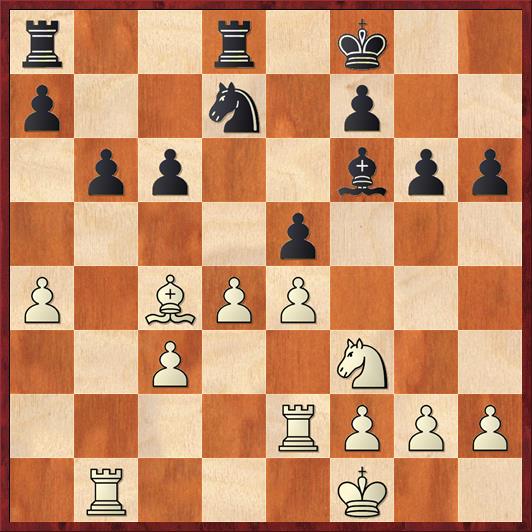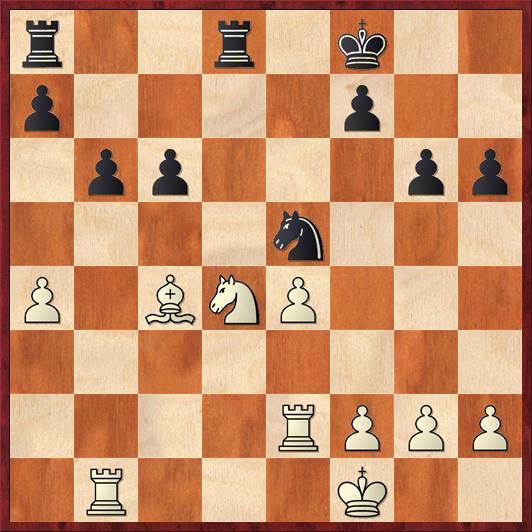I’ve posted here many times before about my training method called “Matrix chess,” which is the only useful way I’ve ever found of training against a computer. (Well, of course you can use computers to study openings, but that’s different. Here I’m talking about trying to use the computer to improve your chess skills.)
In brief, the idea is to play a speed chess or active chess game (I use a 40 move/10 minute time control) against the computer, ideally with its rating set a little bit higher than yours, and allow yourself one and only one “time-out” per game, when you can pause the clock and look at the position for as long as you want to. I feel as if this helps me recognize crucial positions. It also gives me a chance to practice strategical thinking (which I can seldom do well in a rapid chess game) and to practice looking past my first “gut instinct.”
Here’s a nice example that I played just this morning. I was Black, Shredder was White, and its rating was set to 2101.
Position after 24. Bc4. Black to move.
FEN: r2r1k2/p2n1p2/1pp2bpp/4p3/P1BPP3/2P2N2/4RPPP/1R3K2 b – – 0 24
This position came out of a Bishop’s Opening (1. e4 e5 2. Bc4 Nf6 3. d3). As Black, what moves would you consider? Does Black have anything to worry about? Discuss.
The Bishop’s Opening is a little bit like the Ruy Lopez in the sense that it leads to tense positions where, as Black, you’re never quite in trouble but also never quite comfortable. I felt that I had gotten closer to equality when I got the queens off the board, but Black still has several annoying issues. The bishop has no scope and is not really putting effective pressure on White, in part because the knight on d7 is in the way. But the knight can’t really leave d7 because it’s needed to defend e5 (and, possibly, b6). It’s not clear where Black’s play is; and this gives White lots of time to organize the position to his liking.
My “gut instinct” here was to play 24. … a6, and this was the first move I looked at during my timeout. I like to fight for the initiative, and I liked the idea of punching White’s bishop (which just moved Bb3-c4) in the snout with … b5.
But 24. … a6 is also a really weakening move, and I grew very concerned with the variation 25. d5!? b5 26. dc bc 27. cd Rxd7 28. Rb4. Now I can’t defend with the a-rook because 28. … Rc8 runs into 29. Rb6 winning a pawn. So I’ll have to play 29. … Rc7, making my position even more passive. Although I’m not sure if Black is losing, I feel as if I’m getting into a more and more unpleasant position.
The second move I looked at, which seemed really natural to me, was 24. … Rac8, just getting my last piece into play. I was not at all concerned by 25. Ba6 Rc7, which I think helps Black. (Now I’ll be able to play … Nb8 with a tempo and double my rooks on the d-file.)
However, as I looked deeper I realized there were some things I didn’t like about 24. … Rac8. What if White just plays 25. Rd2, planning to increase the pressure on my knight at d7? I can again try 25. … Nb8, hoping for 26. de? Rxd2 27. Nxd2 Bxe5, but White can be more careful and play 26. R1d1. Now the pressure on e5 is really pretty strong, and I may be forced to give in and play 26. … ed 27. cd, giving White a strong center. White’s pawns are better, he has more space, his pieces are better — so this, too, looked like a variation to avoid.
But somewhere around this point, my “spidey sense” started to tingle. If I’m going to be forced to trade on d4 anyway, why not do it right now, when White’s pieces are a little bit disorganized? So I started looking at 24. … ed!?
This is a funny move, one that I would almost never contemplate as Black, because so far my whole strategy has been to maintain the strong point on e5. Taking on d4 seems like capitulation. But this is exactly the kind of “gut instinct” that Matrix chess forces you to re-evaluate!
The first point of 24. … ed is that 25. e5? (superficially impressive) is actually bad after 25. … d3! White’s pieces are thrown into confusion by the interloper pawn. After 26. Re3 Bg7 Black is fine.
The second point is that 24. … ed 25. cd (which the computer actually played) unexpectedly runs into 25. … Bxd4! 26. Nxd4 Ne5!
Position after 26. … Ne5. White to move.
FEN: r2r1k2/p4p2/1pp3pp/4n3/P1BNP3/8/4RPPP/1R3K2 w – – 0 27
What a change in just three moves! Previously Black’s pieces were all getting in each other’s way; now they are coordinating beautifully. Now of course, because I’m playing against a computer, I had some concerns that I might have missed some tricky way for it to stay a piece ahead. But no, there is no tricky way. The two moves that seemed most likely to me were 27. Ne6+ or 27. Nxc6. (I quickly ruled out 27. Bxf7, which is like 27. Ne6+ but worse, after my response 27. … Rxd4.) If 27. Ne6+ fe 28. Bxe6 I really liked Black’s position after either 28. … Rd6 or 28. … Rd4. My knight is better than his bishop, my rooks are going to have great power on the d-file, his a- and e-pawns are weak, and the very unbalanced pawn structure means that there will be good chances for Black to win, not just draw.
Instead the computer played the safer 27. Nxc6 Nxc6 28. Bd5 Rc8, but in this position I thought that Black had completely equalized. Shredder played 29. Rd2 and I played 29. … Ne7, forcing the trade of knight for bishop and thereby eliminating Shredder’s only possible strategic advantage (the B vs. N). After 30. Ke2 Nxd5 31. ed Rd6, the game was eventually drawn.
I think that this is a nice little example of weaving strategy and tactics together. I solved the strategic problem of my poor piece coordination by means of a tactical resource, the temporary bishop sac 25. … Bxd4. But the only reason I even considered this possibility was for strategical reasons: I was unsatisfied with the other moves and I saw that I might need to trade on d4 anyway. Once I overcame my “gut instinct” to never trade on d4, I was able to ask when would be the right time to do so.





{ 3 comments… read them below or add one }
I don’t have any experience with the Black side of this structure, but my first thought in the diagrammed position was to play for g5-g4 to continue fighting for the d4/e5 squares. Unfortunately, White can probably just play g4 himself.
It’s an interesting idea, and it did cross my mind. However, when you play a move like 24. … g5 you are potentially condemning the bishop to a life of passivity, as it may have to defend both the g5 pawn and the e5 pawn. And you create a big weakness on f5. I wouldn’t want to make two concessions this big without a really good reason.
The big question is whether in the very sharp unbalanced position after 27. Ne6+ white’s e and f pawn don’t become too dangerous, supported by the bishop and advancing with potential mating threats.